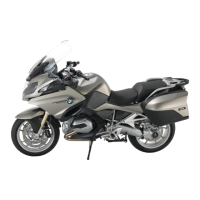clutch in such situations. The
shifting assistant should not
be used in the area of the rev-
limiter.
No shifting support is provided
in the following situations:
If the clutch is operated
If the gear lever is not in the
zero position
When changing up with the
throttle closed (overrunning
mode) or when decelerating.
To be able to make another
gear shift using gear-shift as-
sistance, the gear lever must
be fully released after the first
gear change.
Brakes
How do you achieve
the shortest stopping
distances?
The dynamic load distribution be-
tween the front and rear wheel
changes during braking. The
heavier you brake, the greater
the weight transfer to the front
wheel. Increases in the load at
an individual wheel are accom-
panied by a rise in the effective
braking force that the wheel can
provide.
To achieve the shortest possible
braking distance, the front brake
must be applied quickly and with
increasing force. This procedure
provides ideal exploitation of the
extra weight transfer to the front
wheel. The clutch should also be
disengaged at the same time.
With the extreme emergency
braking technique that motor-
cyclists are often trained to use,
whereby maximum braking force
is applied as rapidly and as pow-
erfully as possible, the dynamic
weight transfer cannot keep up
with the increase in the deceler-
ation rate so that the full braking
force cannot be transferred to
the road surface.
Locking up of the front wheel
is prevented by BMW Motorrad
Integral ABS.
Descending mountain
passes
There is a danger of the
brakes fading if you use
only the rear brakes when
descending mountain passes.
Under extreme conditions, the
brakes could overheat and suffer
severe damage.
Use both front and rear brakes,
and make use of the engine's
braking effect as well.
5
90
z
Riding

